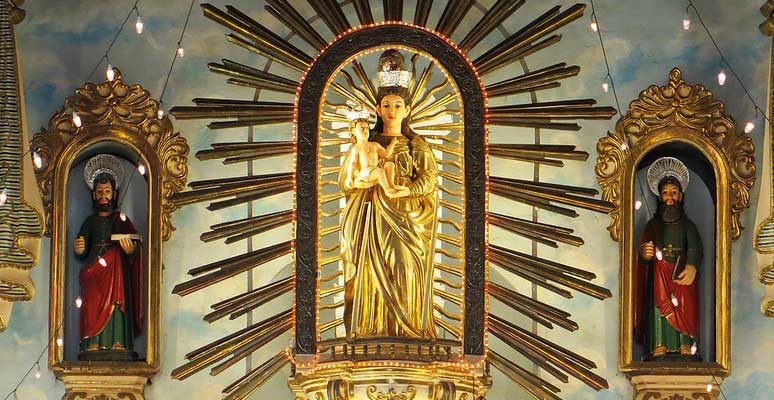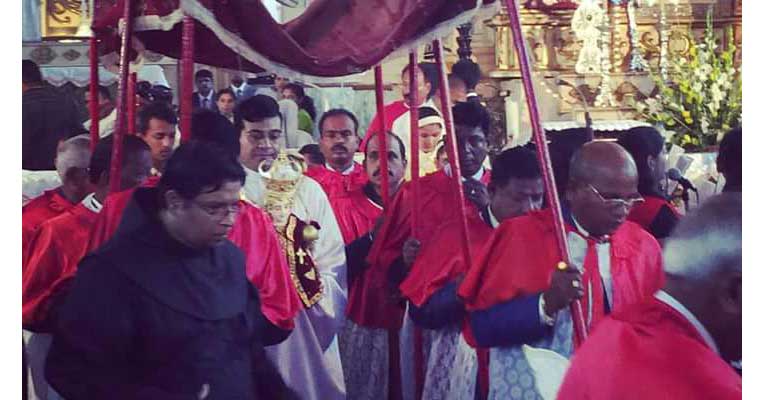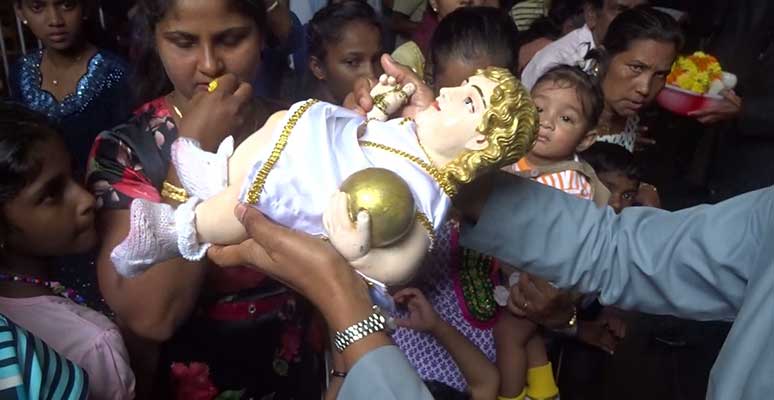Every year, on the second Monday of October, the Church of Our Lady of Mercy, in Colva, celebrates the Colva Fama. A feast of the celebration of infant Jesus. During the feast, a wax statue of the infant Jesus is brought down from the altar and venerated by the devotees. Folks say the statue has miraculous powers.
According to a 17th-century legend, a Jesuit priest and sailor, Fr Benito Fereirra, sj. found the statue off the coast of Mozambique. When Fr. Benito gotwas posted to the church of Our Lady of Mercy, in Colva, Goa, he brought the statue with him and enthroned it on an altar in the church.

Pic credit: joegoauk
Later, when he was transferred to the Rachol seminary, he took the statue with him to the seminary. The villagers begged him to return the statue but he refused. Disappointed, the villagers made their way back. On their return journey, they found a diamond ring (the same ring that was on the finger of the infant Jesus). They rejoiced, went back, made a replica of the statue and put the ring on its finger. Parishioners of the nearby villages of Colva, Sernabatim, Gaundalim and Velim, contributed towards building a separate altar for the statue. To this day they still venerate that statue, which they say has miraculous powers.
During the feast called Colva Fama, devotees are seen queuing up to kiss the statue and offer wax images of different parts of the body (that need healing). The Colva fama is followed by a nine-day novena which culminates in the feast on the 27th of October. Every year, thousands of pious and loyal; devotees throng to the feast. They seek the blessings of Menino (infant) Jesus.

Pic credit: Facebook Goenkar23
The traditional Fama feast features a beautiful legend. It is said that long time ago, possibly during the first Portuguese rule, the fishermen who were at the sea, and occupied in their fishing, saw an enormous flock of sea gulls hovering over a small islet jutting out into the ocean.
As they proceeded towards this islet to research, they found something shiny and reflecting the sun rays. Thinking that it might be an individual needing help, they approached the islet to seek out a gorgeous wooden carved idol of a baby with a hoop on its finger. Possibly it was this that was shining!
Though scared, they removed it and handed it over to the Jesuit priests who were within the Colva Church. They identified it as the image of infant Jesus or ‘Menino Jesus’ and initiated veneration. The news of this find, including many of us claiming miraculous cures and benevolence, led to its fame spreading to all or any corners of the land. The crowds began to swell and this led to the celebrating of the normal Fama.
According to another legend, a Jesuit priest Fr Benito Fereirra SJ, found the statue off the coast of Mozambique, and brought it with him, to the Church of Our Lady of Merces, in Colva, Goa, where he was posted. A place was created on the altar and this idol was placed there.
However, the celebration of this festivity came to a standstill when the Order of the Jesuits was transferred to the Rachol Seminary, and took the idol along side them. The villagers, being emotionally attached to the present deity, visited Rachol and pleaded with them to return the idol to them. Their request was flatly refused. The villagers returned, sad and empty handed.
But once they returned, they found that the ring which was on the finger of the ‘Menino Jesus’, had fallen within the altar niche. Rejoicing over this find, they created another similar idol, put the ring on its finger, and began their veneration.
Every year, the novenas or the religious services start on the second Monday of October, nine days before the feast, and are held to a packed house.
One must attend and see the amazing crowd in well organized queues that represent long periods within the hot sun to urge a chance to kiss the hand of Baby Jesus, and also the ring. Wonderful arrangements are made for devotees and special care is taken of sick patients and other people with disabilities who come to pay their respects.
When you visit here, please note the wrist of the nun who holds the Baby Jesus, as devotees kiss it. You will find the opposite end of a robust string, tied to the ring as a security precaution and to protect against loss.
Being a spiritual feast, visitors and tourists must take all care and maintain high protocol once you enter the Church. After this visit, one can proceed to the pristine Colva Beach and luxuriate in the Goan ambience.


